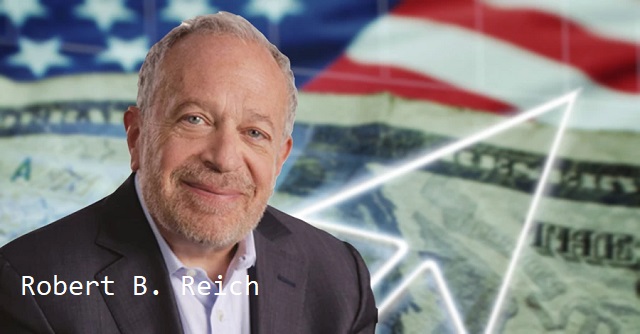Editors’ Note: This article was originally published in 1994 and rings even truer today. Instead of corporations bribing the government into corruption, today government bribes corporations into corruption. It is not a new idea.
When people hear the word “fascism” they naturally think of its ugly racism and anti-Semitism as practiced by the totalitarian regimes of Mussolini and Hitler. But there was also an economic policy component of fascism, known in Europe during the 1920s and ‘30s as “corporatism,” that was an essential ingredient of economic totalitarianism as practiced by Mussolini and Hitler. So-called corporatism was adopted in Italy and Germany during the 1930s and was held up as a “model” by quite a few intellectuals and policy makers in the United States and Europe. A version of economic fascism was in fact adopted in the United States in the 1930s and survives to this day. In the United States these policies were not called “fascism” but “planned capitalism.” The word fascism may no longer be politically acceptable, but its synonym “industrial policy” is as popular as ever.
The Free World Flirts With Fascism
Few Americans are aware of or can recall how so many Americans and Europeans viewed economic fascism as the wave of the future during the 1930s. The American Ambassador to Italy, Richard Washburn Child, was so impressed with “corporatism” that he wrote in the preface to Mussolini’s 1928 autobiography that “it may be shrewdly forecast that no man will exhibit dimensions of permanent greatness equal to Mussolini. . . . The Duce is now the greatest figure of this sphere and time.1” Winston Churchill wrote in 1927 that “If I had been an Italian I am sure I would have been entirely with you” and “don the Fascist black shirt.2” As late as 1940, Churchill was still describing Mussolini as “a great man.”
U.S. Congressman Sol Bloom, Chairman of the House Foreign Relations Committee, said in 1926 that Mussolini “will be a great thing not only for Italy but for all of us if he succeeds. It is his inspiration, his determination, his constant toil that has literally rejuvenated Italy . .”3
One of the most outspoken American fascists was economist Lawrence Dennis. In his 1936 book, The Coming American Fascism, Dennis declared that defenders of “18th-century Americanism” were sure to become “the laughing stock of their own countrymen” and that the adoption of economic fascism would intensify “national spirit” and put it behind “the enterprises of public welfare and social control.” The big stumbling block to the development of economic fascism, Dennis bemoaned, was “liberal norms of law or constitutional guarantees of private rights.”
Certain British intellectuals were perhaps the most smitten of anyone by fascism. George Bernard Shaw announced in 1927 that his fellow “socialists should be delighted to find at last a socialist [Mussolini] who speaks and thinks as responsible rulers do.”4 He helped form the British Union of Fascists whose “Outline of the Corporate State,” according to the organization’s founder, Sir Oswald Mosley, was “on the Italian Model.” While visiting England, the American author Ezra Pound declared that Mussolini was “continuing the task of Thomas Jefferson.”5
Thus, it is important to recognize that, as an economic system, fascism was widely accepted in the 1920s and ‘30s. The evil deeds of individual fascists were later condemned, but the practice of economic fascism never was. To this day, the historically uninformed continue to repeat the hoary slogan that, despite all his faults, Mussolini at least “made the trains run on time,” insinuating that his interventionist industrial policies were a success.
The Italian “Corporatist” System
So-called “corporatism” as practiced by Mussolini and revered by so many intellectuals and policy makers had several key elements:
The state comes before the individual. Webster’s New Collegiate Dictionary defines fascism as “a political philosophy, movement, or regime that exalts nation and often race above the individual and that stands for a centralized, autocratic government.”
This stands in stark contrast to the classical liberal idea that individuals have natural rights that pre-exist government; that government derives its “just powers” only through the consent of the governed; and that the principal function of government is to protect the lives, liberties, and properties of its citizens, not to aggrandize the state.
Mussolini viewed these liberal ideas (in the European sense of the word “liberal”) as the antithesis of fascism: “The Fascist conception of life,” Mussolini wrote, “stresses the importance of the State and accepts the individual only in so far as his interests coincide with the State. It is opposed to classical liberalism [which] denied the State in the name of the individual; Fascism reasserts the rights of the State as expressing the real essence of the individual.”6
Mussolini thought it was unnatural for a government to protect individual rights: “The maxim that society exists only for the well-being and freedom of the individuals composing it does not seem to be in conformity with nature’s plans.”7 “If classical liberalism spells individualism,” Mussolini continued, “Fascism spells government.”
The essence of fascism, therefore, is that government should be the master, not the servant, of the people. Think about this. Does anyone in America really believe that this is not what we have now? Are Internal Revenue Service agents really our “servants”? Is compulsory “national service” for young people, which now exists in numerous states and is part of a federally funded program, not a classic example of coercing individuals to serve the state? Isn’t the whole idea behind the massive regulation and regimentation of American industry and society the notion that individuals should be forced to behave in ways defined by a small governmental elite? When the nation’s premier health-care reformer recently declared that heart bypass surgery on a 92-year-old man was “a waste of resources,” wasn’t that the epitome of the fascist ideal—that the state, not individuals, should decide whose life is worthwhile, and whose is a “waste”?
The U.S. Constitution was written by individuals who believed in the classical liberal philosophy of individual rights and sought to protect those rights from governmental encroachment. But since the fascist/collectivist philosophy has been so influential, policy reforms over the past half century have all but abolished many of these rights by simply ignoring many of the provisions in the Constitution that were designed to protect them. As legal scholar Richard Epstein has observed: “[T]he eminent domain . . . and parallel clauses in the Constitution render . . . suspect many of the heralded reforms and institutions of the twentieth century: zoning, rent control, workers’ compensation laws, transfer payments, progressive taxation.”8 It is important to note that most of these reforms were initially adopted during the ‘30s, when the fascist/collectivist philosophy was in its heyday.
Planned industrial “harmony.” Another keystone of Italian corporatism was the idea that the government’s interventions in the economy should not be conducted on an ad hoc basis, but should be “coordinated” by some kind of central planning board. Government intervention in Italy was “too diverse, varied, contrasting. There has been disorganic . . . intervention, case by case, as the need arises,” Mussolini complained in 1935.9 Fascism would correct this by directing the economy toward “certain fixed objectives” and would “introduce order in the economic field.”10 Corporatist planning, according to Mussolini adviser Fausto Pitigliani, would give government intervention in the Italian economy a certain “unity of aim,” as defined by the government planners.11
These exact sentiments were expressed by Robert Reich (currently the U.S. Secretary of Labor) and Ira Magaziner (currently the federal government’s health care reform “Czar”) in their book Minding America’s Business.12 In order to counteract the “untidy marketplace,” an interventionist industrial policy “must strive to integrate the full range of targeted government policies—procurement, research and development, trade, antitrust, tax credits, and subsidies—into a coherent strategy . . . .”13
Current industrial policy interventions, Reich and Magaziner bemoaned, are “the product of fragmented and uncoordinated decisions made by [many different] executive agencies, the Congress, and independent regulatory agencies . . . . There is no integrated strategy to use these programs to improve the . . . U.S. economy.”14
In his 1989 book, The Silent War, Magaziner reiterated this theme by advocating a coordinating group like the national Security Council to take a strategic national industrial view.”15] The White House has in fact established a “National Economic Security Council.” Every other advocate of an interventionist “industrial policy” has made a similar “unity of aim” argument, as first described by Pitigliani more than half a century ago.
Government-business partnerships. A third defining characteristic of economic fascism is that private property and business ownership are permitted, but are in reality controlled by government through a business-government “partnership.” As Ayn Rand often noted, however, in such a partnership government is always the senior or dominating “partner.”
In Mussolini’s Italy, businesses were grouped by the government into legally recognized “syndicates” such as the “National Fascist Confederation of Commerce,” the “National Fascist Confederation of Credit and Insurance,” and so on. All of these “fascist confederations” were “coordinated” by a network of government planning agencies called “corporations,” one for each industry. One large “National Council of Corporations” served as a national overseer of the individual “corporations” and had the power to “issue regulations of a compulsory character.”16
The purpose of this byzantine regulatory arrangement was so that the government could “secure collaboration . . . between the various categories of producers in each particular trade or branch of productive activity.”17 Government-orchestrated “collaboration” was necessary because “the principle of private initiative” could only be useful “in the service of the national interest” as defined by government bureaucrats.18
This idea of government-mandated and -dominated “collaboration” is also at the heart of all interventionist industrial policy schemes. A successful industrial policy, write Reich and Magaziner, would “require careful coordination between public and private sectors.”19 “Government and the private sector must work in tandem.”20 “Economic success now depends to a high degree on coordination, collaboration, and careful strategic choice,” guided by government.21
The AFL-CIO has echoed this theme, advocating a “tripartite National Reindustrialization Board—including representatives of labor, business, and government” that would supposedly “plan” the economy.[22 The Washington, D.C.-based Center for National Policy has also published a report authored by businessmen from Lazard Freres, du Pont, Burroughs, Chrysler, Electronic Data Systems, and other corporations promoting an allegedly “new” policy based on “cooperation of government with business and labor.”23 Another report, by the organization “Rebuild America,” co-authored in 1986 by Robert Reich and economists Robert Solow, Lester Thurow, Laura Tyson, Paul Krugman, Pat Choate, and Lawrence Chimerine urges “more teamwork” through “public-private partnerships among government, business and academia.”24 This report calls for “national goals and targets” set by government planners who will devise a “comprehensive investment strategy” that will only permit “productive” investment, as defined by government, to take place.
Mercantilism and protectionism. Whenever politicians start talking about “collaboration” with business, it is time to hold on to your wallet. Despite the fascist rhetoric about “national collaboration” and working for the national, rather than private, interests, the truth is that mercantilist and Protectionist practices riddled the system. Italian social critic Gaetano Salvemini wrote in 1936 that under corporatism, “it is the state, i.e., the taxpayer, who has become responsible to private enterprise. In Fascist Italy the state pays for the blunders of private enterprise.”25 As long as business was good, Salvemini wrote, “profit remained to private initiative.”26 But when the depression came, “the government added the loss to the taxpayer’s burden. Profit is private and individual. Loss is public and social.”27
The Italian corporative state, The Economist editorialized on July 27, 1935, “only amounts to the establishment of a new and costly bureaucracy from which those industrialists who can spend the necessary amount, can obtain almost anything they want, and put into practice the worst kind of monopolistic practices at the expense of the little fellow who is squeezed out in the process.” Corporatism, in other words, was a massive system of corporate welfare. “Three-quarters of the Italian economic system,” Mussolini boasted in 1934, “had been subsidized by government.”28
If this sounds familiar, it is because it is exactly the result of agricultural subsidies, the Export-Import bank, guaranteed loans to “preferred” business borrowers, protectionism, the Chrysler bailout, monopoly franchising, and myriad other forms of corporate welfare paid for directly or indirectly by the American taxpayer.
Another result of the close “collaboration” between business and government in Italy was “a continual interchange of personnel between the . . . civil service and private business.”29 Because of this “revolving door” between business and government, Mussolini had “created a state within the state to serve private interests which are not always in harmony with the general interests of the nation.”30
Mussolini’s “revolving door” swung far and wide:
Signor Caiano, one of Mussolini’s most trusted advisers, was an officer in the Royal Navy before and during the war; when the war was over, he joined the Orlando Shipbuilding Company; in October 1922, he entered Mussolini’s cabinet, and the subsidies for naval construction and the merchant marine came under the control of his department. General Cavallero, at the close of the war, left the army and entered the Pirelli Rubber Company . . . ; in 1925 he became undersecretary at the Ministry of War; in 1930 he left the Ministry of War, and entered the service of the Ansaldo armament firm. Among the directors of the big . . . companies in Italy, retired generals and generals on active service became very numerous after the advent of Fascism.31
Such practices are now so common in the United States—especially in the defense industries—that it hardly needs further comment.
From an economic perspective, fascism meant (and means) an interventionist industrial policy, mercantilism, protectionism, and an ideology that makes the individual subservient to the state. “Ask not what the State can do for you, but what you can do for the State” is an apt description of the economic philosophy of fascism.
The whole idea behind collectivism in general and fascism in particular is to make citizens subservient to the state and to place power over resource allocation in the hands of a small elite. As stated eloquently by the American fascist economist Lawrence Dennis, fascism “does not accept the liberal dogmas as to the sovereignty of the consumer or trader in the free market . . . .
Least of all does it consider that market freedom, and the opportunity to make competitive profits, are rights of the individual.” Such decisions should be made by a “dominant class” he labeled “the elite.”32
German Economic Fascism
Economic fascism in Germany followed a ‘virtually identical path. One of the intellectual fathers of German fascism was Paul Lensch, who declared in his book Three Years of World Revolution that “Socialism must present a conscious and determined opposition to individualism.”33 The philosophy of German fascism was expressed in the slogan, Gemeinnutz geht vor Eigennutz, which means “the common good comes before the private good.” “The Aryan is not greatest in his mental qualities,” Hitler stated in Mein Kampf, but in his noblest form he “willingly subordinates his own ego to the community and, if the hour demands, even sacrifices it.”34 The individual has “not rights but only duties.”35
Armed with this philosophy, Germany’s National Socialists pursued economic policies very similar to Italy’s: government-mandated “partnerships” between business, government, and unions organized by a system of regional “economic chambers,” all overseen by a Federal Ministry of Economics.
A 25-point “Programme of the Party” was adopted in 1925 with a number of economic policy “demands,” all prefaced by the general statement that “the activities of the individual must not clash with the interests of the whole . . . but must be for the general good.”36 This philosophy fueled a regulatory assault on the private sector. “We demand ruthless war upon all those whose activities are injurious to the common interest,” the Nazis warned.37 And who are these on whom “war” is to be waged? “Common criminals,” such as “usurers,” i.e., bankers, and other “profiteers,” i. e., ordinary businessmen in general. Among the other policies the Nazis demanded were abolition of interest; a government-operated social security system; the ability of government to confiscate land without compensation (wetlands regulation?); a government monopoly in education; and a general assault on private-sector entrepreneurship which was denounced as the “Jewish materialist spirit.”38 Once this “spirit” is eradicated, “The Party . . . is convinced that our nation can achieve permanent health from within only on the principle: the common interest before self-interest.”39
Conclusions
Virtually all of the specific economic policies advocated by the Italian and German fascists of the 1930s have also been adopted in the United States in some form, and continue to be adopted to this day. Sixty years ago, those who adopted these interventionist policies in Italy and Germany did so because they wanted to destroy economic liberty, free enterprise, and individualism. Only if these institutions were abolished could they hope to achieve the kind of totalitarian state they had in mind.
Many American politicians who have advocated more or less total government control over economic activity have been more devious in their approach. They have advocated and adopted many of the same policies, but they have always recognized that direct attacks on private property, free enterprise, self-government, and individual freedom are not politically palatable to the majority of the American electorate. Thus, they have enacted a great many tax, regulatory, and income-transfer policies that achieve the ends of economic fascism, but which are sugar-coated with deceptive rhetoric about their alleged desire only to “save” capitalism.
American politicians have long taken their cue in this regard from Franklin D. Roosevelt, who sold his National Recovery Administration (which was eventually ruled unconstitutional) on the grounds that “government restrictions henceforth must be accepted not to hamper individualism but to protect it.”40 In a classic example of Orwellian doublespeak, Roosevelt thus argued that individualism must be destroyed in order to protect it.
Now that socialism has collapsed and survives nowhere but in Cuba, China, Vietnam, and on American university campuses, the biggest threat to economic liberty and individual freedom lies in the new economic fascism. While the former Communist countries are trying to privatize as many industries as possible as fast as they can, they are still plagued by governmental controls, leaving them with essentially fascist economies: private property and private enterprise are permitted, but are heavily controlled and regulated by government.
As most of the rest of the world struggles to privatize industry and encourage free enterprise, we in the United States are seriously debating whether or not we should adopt 1930s-era economic fascism as the organizational principle of our entire health care system, which comprises 14 percent of GNP. We are also contemplating business-government “partnerships” in the automobile, airlines, and communications industries, among others, and are adopting government-managed trade policies, also in the spirit of the European corporatist schemes of the 1930s.
The state and its academic apologists are so skilled at generating propaganda in support of such schemes that Americans are mostly unaware of the dire threat they pose for the future of freedom. The road to serfdom is littered with road signs pointing toward “the information superhighway,” “health security,” “national service,” “managed trade,” and “industrial policy.”
*****
Note: Access all numbered references in the article above at the This Article link below.
This article was published on September 3, 2021 and is reproduced with permission from the Ludwig von Mises Institute.








